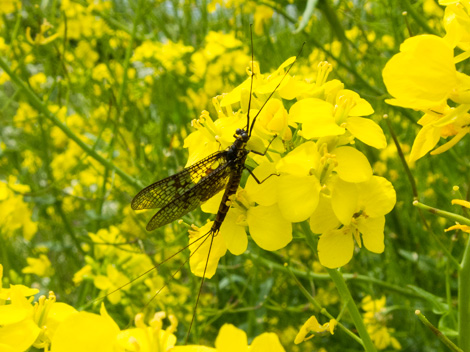Another day, another chance to find something new. I decided to go along the river today and hired a Boris bike to increase my exploratory range. I wanted to try and record some warblers in the reeds but the constant roar of traffic and building work meant that was a non-starter.
The river banks were full of rape flowers and cow parsley. The yellow of the rape was attracting quite a few red-tailed bumblebee workers and lower down there were some flowering nettles with carder bees buzzing about.
Further along the path I noticed a pair of dark coloured insects fluttering up and down in the air, almost landing, but not quite. They managed to dance for a short while before a breeze knocked them out of the air and onto the flowers. Time for my trusty close up binoculars whilst trying to keep the bicycle upright. A long body with what looked like three filaments at the end, bulging eyes and large, dark patterned wings. I was quite hopeful that this was a mayfly, my first ever. I grabbed my camera but only managed to get one quick shot off before it wised up to me and flew away.
Fortunately it wasn’t too bad, even the exposure wasn’t that bad considering the brightness of the flowers.
This was indeed a mayfly, Ephemera vulgata, one of 51 species of mayfly that live in the UK. Apparently the term mayfly is misleading (although it is still May) as they fly throughout the summer months. The name mayfly refers to a particular species that was usually first seen when the May (hawthorn) was in blossom. Another name for them is dayfly, as many of the adults live for only one day (or sometimes just a few hours) – not having any mouthparts or digestive organs being on the wing only long enough to find a mate and lay its eggs underwater. But this is not true of all mayflies, some live for longer than a day. Most of their life is spent as an underwater nymph, whiling away a year or two eating algae and other vegetation before emerging and flying to the bank and sheltering under leaves. Here they moult again and become a dancing, fluttering fly.
